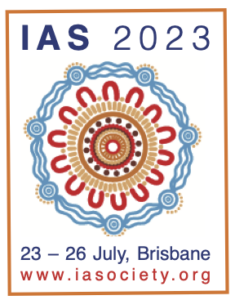IAS 2023: CHAPAS-4 supports better second-line options for children
1 September 2023. Related: Conference reports, Paediatric care.
Polly Clayden, HIV i-Base

Tenofovir alafenamide (TAF)/emtricitabine (FTC) and dolutegravir (DTG) were virologically superior to abacavir (ABC) or zidovudine (AZT)/lamivudine (3TC) and boosted lopinavir (LPV/r) and atazanavir (ATV/r), respectively, in the second-line paediatric CHAPAS-4 trial.
These findings were shown at IAS 2023. [1]
There are limited options and formulations for second-line ART available for children living with HIV. The current LPV/r-based standard of care needs to be taken twice daily. And although TAF has been highlighted as a priority agent for children (who cannot use TDF because of renal and bone toxicity), this has been based on limited evidence.
CHAPAS-4 (Children with HIV in Africa: Pharmacokinetics and Acceptability of Simple novel second-line antiretroviral agents) looked at long-term outcomes for children switching from NNRTI-based first-line to second-line ART. The trial evaluated a number of options.
It was a 4×2 factorial open-label trial, conducted in Uganda, Zambia and Zimbabwe.
A total of 919 children and adolescents, aged 3–15 years, failing first-line ART, were randomised to TAF/FTC vs ABC or AZT/3TC (standard of care) and in turn to DTG vs DRV/r vs ATV/r vs LPV/r (standard of care). All were dosed according to WHO weight bands.
The primary endpoint was viral load <400 copies/mL at week-96. The investigators hypothesised: TAF/FTC would be non-inferior to standard of care (10% margin); ATV/r non-inferior to LPV/r (12% margin); DRV/r and DTG superior to LPV/r and ATV/r arms combined (superiority threshold p=0.03, as multiple comparisons). The primary analysis was intention-to-treat.
Participants were 54% male, median age 10 years, CD4 669 cells/mm3 and viral load 17,573 copies/mL. They had been on first-line ART for a median of 5.6 years: 53% received ABC and 47% AZT and 57% efavirenz (EFV) and 44% nevirapine (NVP0.
Over 96 weeks only 11 (1.2%) participants were lost to follow up and 98% of time was spent on the original allocated regimen; 5 (0.5%) started third-line ART.
At week-96, TAF/FTC was superior to ABC or AZT: 89.4% vs 83.3% respectively viral load <400 copies/mL (p=0.004). ATV/r was non-inferior to LPV/r (p=0.33). DTG was superior to LPV/r and ATV/r: 92% vs 82.5% respectively viral load <400 copies/mL (p<0.0001). DRV/r showed a trend to superiority to LPV/r and ATV/r (p=0.04).
These effects were similar for viral load <60 copies/mL, at weeks 48 and 144, by per-protocol analysis and by subgroup analyses (first-line NRTIs and NNRTIs, sex, weight and CD4)
CD4 count improved in all participants – there was no difference by arms.
There was no difference in adverse events (AE) between NRTIs. There were more grade 3/4 AE, mostly hyperbilirubinemia, ATV/r vs LPV/r (p<0.0001). DTG had fewer AE vs LPV/r (p=0.02).
There was increased total and LDL cholesterol in LPV/r vs other arms (p<0.001 and p=0.0002, respectively)
Improvement in growth parameters were greater with TAF and with DTG. Participants on LPV/r had the least weight gain.
There was no excess weight gain with DTG and TAF.
comment
A generic formulation containing TAF for children has been on the WHO PADO priority list for some time now, so these supporting data from CHAPAS are very welcome. [2]
This needs to be either a dual formulation combined with 3TC or FTC or a fixed dose triple combination with additional DTG, to be used over WHO weight-bands 3–25 kg. These formulations would give alternatives to ABC-based regimens and mean that all age groups have access to a tenofovir-based regimen. The triple fixed-dose combination could be used in both first- and second-line paediatric treatment and both formulations would be good news as the dual combination could also be used with DRV/r.
The ongoing UNIVERSAL project includes pharmacokinetic (PK) modelling and bioavailability studies of TAF and DTG/TAF/3TC dose ratio. [3]
A recent announcement from Gilead stated that the company (originator manufacturer of F/TAF) will provide a technology transfer of currently available data for a dispersible formulation of F/TAF and supporting PK data. [4]
PENTA (within the UNIVERSAL project) will develop the PK modelling and clinical studies, and CHAI, will be in charge of the global access strategy, in collaboration with two generic manufacturers.
Progress has also been made in developing a DRV/r fixed-dose combination (120 mg of DRV plus 20 mg of ritonavir) for second-line treatment in children with resistance to DTG, within this initiative.
These plans are aligned with the WHO Global Accelerator for Pediatric Formulation (GAP-f). [5]
References
- Musiime V et al. Increasing second-line antiretroviral therapy options for children with HIV in Africa: week-96 efficacy and safety results of the CHAPAS-4 randomised trial. IAS 2023. Brisbane. Australia. 23–26 July 2023. Oral abstract 5764.
https://ias.reg.key4events.com/key4register/AbstractList.aspx?e=96&preview=1&aig=-1&ai=52421 (abstract)
https://conference.ias2023.org/media-1110-track-b-late-breaker (webcast) - WHO. Priorities for antiretroviral drug optimization in adults and children report of a CADO, PADO and HIVResNet joint meeting. 25 July 2022.
https://www.who.int/publications/i/item/9789240053038 - UNIVERSAL.
https://universalproject.org - Gilead press release. Gilead partners with CHAI and Penta to improve treatment and adherence rates among children with HIV in low and middle income countries. 13 July 2023.
https://www.gilead.com/news-and-press/press-room/press-releases/2023/7/gilead-partners-with-chai-and-penta-to-improve-treatment-and-adherence-rates-among-children-with-hiv-in-low-and-middle-income-countries - WHO. Global Accelerator for Paediatric Formulations Network (GAP-f)
https://www.who.int/initiatives/gap-f
This report was first published on 9 August 2023.

